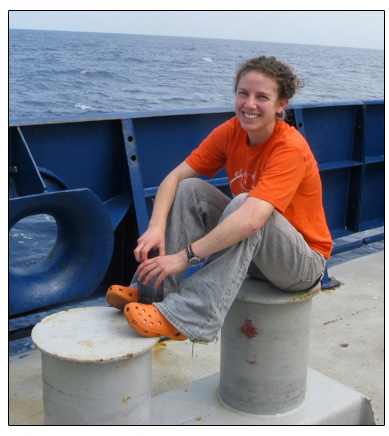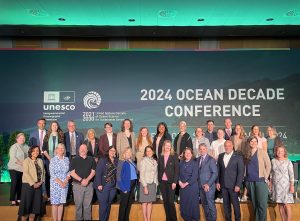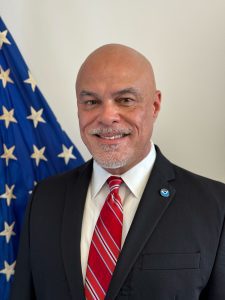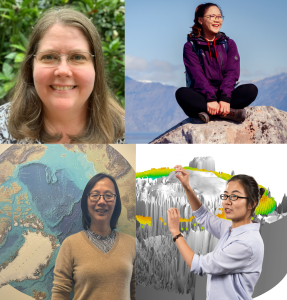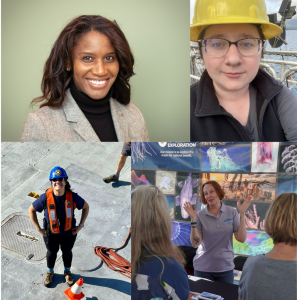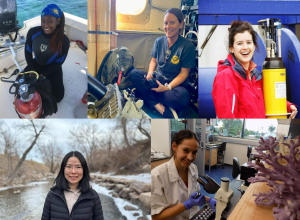Mining the Deep Ocean for Climate Clues
The deep ocean, one of the most mysterious places on Earth, is an integral if unseen part of our climate system. Its currents, temperature, and other traits influence the middle and upper layers of the ocean which in turn influence the winds and temperatures of the atmosphere above. In order to better understand the whole climate system, researchers like Sarah Purkey gather and analyze data from the deep ocean.
Purkey is a graduate student working at NOAA’s Pacific Marine Environmental Laboratory in Seattle, Wash. She has gone on a number of NOAA research cruises as part of her work towards a doctoral degree in oceanography from the University of Washington. Read her profile below to learn about the creative way she used technology in researching career options.
Why does your research matter?
I study deep ocean warming trends during the past 30 years. The ocean is the largest sink of excess heat in the earth system. Accurately quantifying how much energy is entering the ocean is important for understanding the effects of climate change and monitoring sea level rise. The deep warming is greatest around Antarctica where cold dense water sinks from the surface to the deep oceans, indicating that the warming could be caused by a decrease in the deep water sinking rate, possibly in response to climate change.
What do you enjoy the most about your work?
I really enjoy doing fieldwork. I have been fortunate enough to have had the opportunity to do a number of scientific cruises all over the world since coming to NOAA in 2007. Collecting data is a lot of work but it is also a very unique experience and can be a lot fun.
Where do you do most of your work? In a lab? In field studies?
Most of my time is spent on my computer doing data analysis. I work with a very large observational data set containing water temperature and salinity at different depths, collected around the world on hundreds of different cruises. The data have all already been collected and are publicly available. My job involves organizing the data and looking at how the deep ocean has changed with time.
What in your lab could you not live without?
The data I use have been collected using an instrument called a conductivity-temperature-depth sensor or CTD. Our CTDs are deployed from ships and give us extremely accurate salinity and temperature profiles of the entire water column. This is currently the best way we have for sampling the deep oceans. The extremely high level of accuracy of these instruments is what allows me to measure tiny temperature and salinity changes in the deep ocean.
If you could invent any instrument to advance your research and cost were no object, what would it be? Why?
While I love going to sea, only being able to collect deep ocean data by ship-based work limits our ability to monitor the deep ocean changes. It would be fantastic if autonomous floats or gliders could reach all the way to the sea bottom. This is something scientists are currently working on and hopefully will be in use soon, but it will still take years and a lot of money before we have a sampling array that monitors the deep ocean.
When did you know you wanted to pursue science?
I have always liked the idea of scientific exploration, but I didn’t start thinking about physical oceanography until after I graduated college. I was a math-physics major in college and was teaching in a high school, having tried a range of other jobs since leaving school. Not sure of exactly what I should do with my life, I typed a list of my favorite things into a Google search. The top search result was physical oceanography, an area of science I had never heard of before. This was the first time I realized that there were jobs out there where people were paid to study the physics of the ocean. The more I read, the more I was fascinated by the field and it didn’t take long for me to decide that this would be the coolest job ever. Shortly after, I started looking at graduate schools.
What’s at the top of your recommended reading list for someone wanting to explore a career in science?
Darwin’s The Origin of Species. This might sound like a weird book to recommend, but we had to read it in college, and I thought it was great piece of history and science. If you want to read a book about scientific discoveries, evolution seems like a good place to start.
And how about a personal favorite book?
I enjoyed Life of Pi by Yann Martel. It is about a boy lost at sea after a shipwreck.
What part of your job as a NOAA scientist did you least expect to be doing?
I’m not sure. I worked in the lab before going back to school, so I had a pretty good idea what I was getting myself into. But I am still a graduate student, so I have many more years of unexpected work to look forward to.
Do you have an outside hobby?
Outside of work, I enjoy playing soccer, running, hiking, climbing, and snowboarding.
What would you be doing if you had not become a scientist?
I think I would have become a high school science or math teacher.
Who is your favorite historical scientist and why?
I would pick Isaac Newton. Force equals mass times acceleration is a pretty brilliantly simply way to explain motion and is the fundamental equation of ocean physics. A lot of physical oceanography can be summarized as scientists trying to accurately describe F and then trying to figure out how to solve that equation.
Sarah Purkey is working on a doctoral degree in the School of Oceanography at the University of Washington. Her adviser is Gregory C. Johnson of the NOAA Pacific Marine Environmental Lab in Seattle, Wash. She earned her bachelor’s degree in mathematics-physics at Whitman College in Walla Walla, Wash., in 2005. ![]()
![]()
